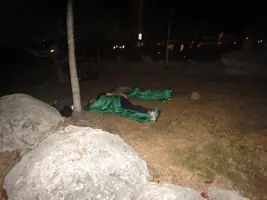As teams are getting their home-on-wheels pimped out, the team captain checks in. Side note: there are 500 teams; teams start at various times, pending their pace.
Once teams are checked in, the whole team has to go through a mandatory safety course. Runners are reminded the rules of the relay, what to do if lost, times to wear reflective gear and lights, and what to do if there's an emergency.
After the safety course, teams gather together and motivate their first runner. Music is blaring and the energy is high at the start line. Spectators stand on the sides cheering on the first runner. Teams know that the next 24 to 36 hours will challenge everyone physically and mentally, yet it's an experience of a lifetime. Right away you feel the spirit of camaraderie; it's a community that no other race offers.
Roll call is announced and the countdown begins. The gun is shot and runners take off on their 200-mile journey.
More: 10 Race-Day Preparation Tips
Now you may think teams race to their vans and hit the road, but that's not the case. The first runner has a few miles to run; teams have some time. Teams mingle for a little bit and get to know other runners. Some head off to the store to pick up water, first-aid, food, or other necessary items they need. Then they hit the road, honking their horns ready to take over the streets.
It's fascinating to see runner after runner on the side of the road, with decked out vans following.
The first day is filled with high energy and humorous spirits—some runners wear hilarious and unique costumes. Tutus, swimming briefs, super heroes, and 80's attire are just a few outfits seen along the course.
The day continues into night. Runners keep running, vans keep driving, and runners sleep in the van when they have a chance. This is when mind over matter kicks in.
Night Run
The sun goes down and the temperatures cool off. It's just the runner and the road (and passing cars). But, as runners continue to run into the wee hours, there are few cars that pass by. It's just you, other runners (if they are nearby) and a star-filled sky. You hear your feet hit the pavement, heart pound, and breath become deeper and deeper. You see red blinking lights 100 or so yards in front of you. It might be a runner or a sign with direction. It's a time where you have to mentally tell yourself to get through the next leg.You are tired, cold, and hungry. You start thinking, "Maybe I'll just walk a little to get some energy." But then a team van pulls up on the side of the course and says, "Looking good, keep up the pace. Two miles left, keep it up." Suddenly a burst of energy comes over you and you push yourself harder than before. You see the one-mile marker and a feeling of excitement goes through your body. You know you are almost there.
As you get closer to the exchange, teams crowd the exchange line and cheer you on. Your baton—a slap bracelet—gets passed onto the next runner's wrist; they take off and you get to rest. Two legs down, one more to go.
More: 5 Tips for Night Running
It's time for you to rest. Where do you sleep? In the van or camped out on a patch of grass? That's exactly what many runners do to catch an hour or two of sleep—camp out. People find little patches of grass at the designated sleeping exchanges, and camp out under the stars. With security around manning the area, you can feel comfortable shutting your eyes and catching a snooze.
|
Runner's catch a quick snooze. |




